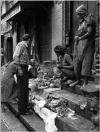Resumo
As práticas de conservação do património urbano pode promover mudanças na estrutura social eeconômica local, ou seja, uma perda de diversidade social e de especialização da economia local, emmuitos casos levou a servir apenas um grupo: os turistas. Para combater esta tendência a produzir cidade-museu dosbairros tradicionais, é necessário identificar os elementos tangíveis e intangíveis que contribuem para manter as categorias sociaisde residentes e residentes com seus costumes relacionados com o espaço. Quando da negociação na rua serve principalmente osresidentes e inserido em uma vasta gama de produtos e formas de venda e de troca também são diferentes, a conservação desteelemento do espaço pode contribuir para manter as qualidades de um bairro como lugar “para todos”.La revista Apuntes se encuentra registrada bajo la licencia Creative Commons Reconocimiento 4.0 Internacional. Por lo tanto, esta obra se puede reproducir, distribuir y comunicar públicamente en formato digital, siempre que se reconozca el nombre de los autores y a la Pontificia Universidad Javeriana. Se permite citar, adaptar, transformar, autoarchivar, republicar y crear a partir del material, para cualquier finalidad (incluso comercial), siempre que se reconozca adecuadamente la autoría, se proporcione un enlace a la obra original y se indique si se han realizado cambios. La Pontificia Universidad Javeriana no retiene los derechos sobre las obras publicadas y los contenidos son responsabilidad exclusiva de los autores, quienes conservan sus derechos morales, intelectuales, de privacidad y publicidad.
El aval sobre la intervención de la obra (revisión, corrección de estilo, traducción, diagramación) y su posterior divulgación se otorga mediante una licencia de uso y no a través de una cesión de derechos, lo que representa que la revista y la Pontificia Universidad Javeriana se eximen de cualquier responsabilidad que se pueda derivar de una mala práctica ética por parte de los autores. En consecuencia de la protección brindada por la licencia de uso, la revista no se encuentra en la obligación de publicar retractaciones o modificar la información ya publicada, a no ser que la errata surja del proceso de gestión editorial. La publicación de contenidos en esta revista no representa regalías para los contribuyentes.


